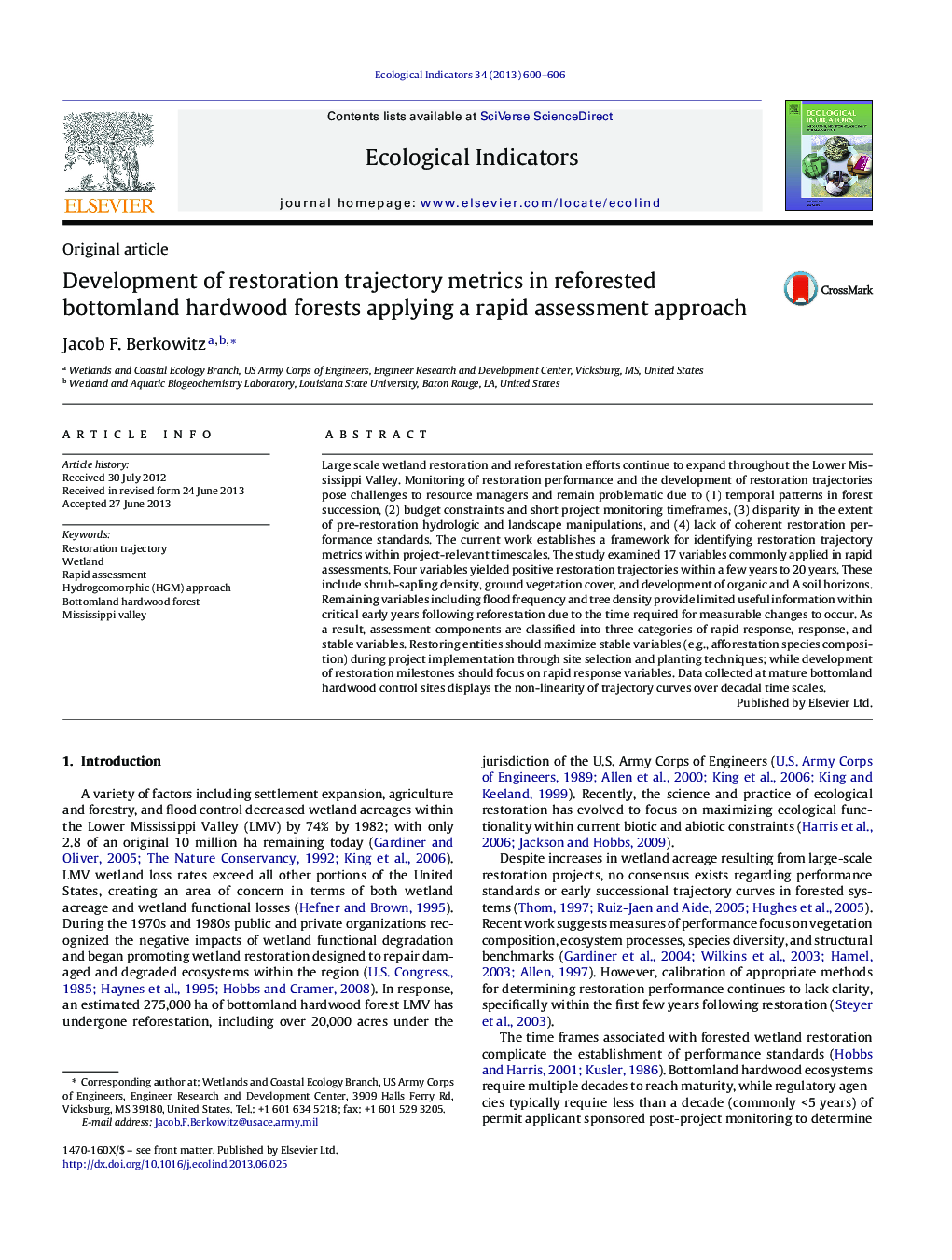| کد مقاله | کد نشریه | سال انتشار | مقاله انگلیسی | نسخه تمام متن |
|---|---|---|---|---|
| 6295370 | 1617166 | 2013 | 7 صفحه PDF | دانلود رایگان |
عنوان انگلیسی مقاله ISI
Development of restoration trajectory metrics in reforested bottomland hardwood forests applying a rapid assessment approach
ترجمه فارسی عنوان
توسعه معیارهای مسیر ترمیم در جنگل های جنگل دشت جنگلی با استفاده از روش ارزیابی سریع
دانلود مقاله + سفارش ترجمه
دانلود مقاله ISI انگلیسی
رایگان برای ایرانیان
کلمات کلیدی
ترجمه چکیده
تلاش های بزرگ تربیت تالاب ها و تلاش های جنگل زدایی همچنان در سراسر دره میسیسیپی پایین ادامه دارد. نظارت بر عملکرد بازسازی و توسعه مسیرهای ترمیم، چالش هایی را به مدیران منابع ایجاد می کند و با توجه به (1) الگوهای زمانی در جانشینی جنگل، (2) محدودیت های بودجه و دوره های کوتاه مدت نظارت بر پروژه، مشکل ساز می شود؛ (3) بازسازی هیدرولوژیکی و دستکاری های چشم انداز، و (4) عدم وجود استانداردهای عملکرد مرمت انسجام. کار جاری یک چارچوب برای شناسایی معیارهای مسیر ترمیم را در زمان های مربوط به پروژه ایجاد می کند. این مطالعه 17 متغیر را که معمولا در ارزیابی های سریع انجام می شود مورد بررسی قرار داد. چهار متغیر طی چند سال تا 20 سال مسیرهای مثبت ترمیم را به دست آوردند. این شامل تراکم بوته نهال، پوشش گیاهی زمینی و توسعه افق های آلی و آبی است. متغیرهای باقی مانده، از جمله فراوانی سیل و تراکم درخت، در طول سال های حیاتی پس از جنگل زدایی، به دلیل زمان لازم برای تغییرات قابل اندازه گیری رخ می دهد، اطلاعات محدودی را در طول سال های حیاتی ارائه می دهند. در نتیجه، اجزای ارزیابی به سه دسته پاسخ سریع، پاسخ و متغیرهای پایدار طبقه بندی می شوند. نهادهای بازسازی باید حداکثر سازی متغیرهای پایدار (مثلا ترکیب گونه های جنگل) را در طول اجرای پروژه از طریق انتخاب محل و تکنیک های کاشت، در حالیکه توسعه مراحل بازسازی باید بر متغیرهای پاسخ سریع متمرکز شود. داده های جمع آوری شده در سایت های کنترل جنگل های دشت بالغ نمایش غیر خطی بودن منحنی های مسیر را در مقیاس زمانی دهه ها نشان می دهد.
موضوعات مرتبط
علوم زیستی و بیوفناوری
علوم کشاورزی و بیولوژیک
بوم شناسی، تکامل، رفتار و سامانه شناسی
چکیده انگلیسی
Large scale wetland restoration and reforestation efforts continue to expand throughout the Lower Mississippi Valley. Monitoring of restoration performance and the development of restoration trajectories pose challenges to resource managers and remain problematic due to (1) temporal patterns in forest succession, (2) budget constraints and short project monitoring timeframes, (3) disparity in the extent of pre-restoration hydrologic and landscape manipulations, and (4) lack of coherent restoration performance standards. The current work establishes a framework for identifying restoration trajectory metrics within project-relevant timescales. The study examined 17 variables commonly applied in rapid assessments. Four variables yielded positive restoration trajectories within a few years to 20 years. These include shrub-sapling density, ground vegetation cover, and development of organic and A soil horizons. Remaining variables including flood frequency and tree density provide limited useful information within critical early years following reforestation due to the time required for measurable changes to occur. As a result, assessment components are classified into three categories of rapid response, response, and stable variables. Restoring entities should maximize stable variables (e.g., afforestation species composition) during project implementation through site selection and planting techniques; while development of restoration milestones should focus on rapid response variables. Data collected at mature bottomland hardwood control sites displays the non-linearity of trajectory curves over decadal time scales.
ناشر
Database: Elsevier - ScienceDirect (ساینس دایرکت)
Journal: Ecological Indicators - Volume 34, November 2013, Pages 600-606
Journal: Ecological Indicators - Volume 34, November 2013, Pages 600-606
نویسندگان
Jacob F. Berkowitz,
